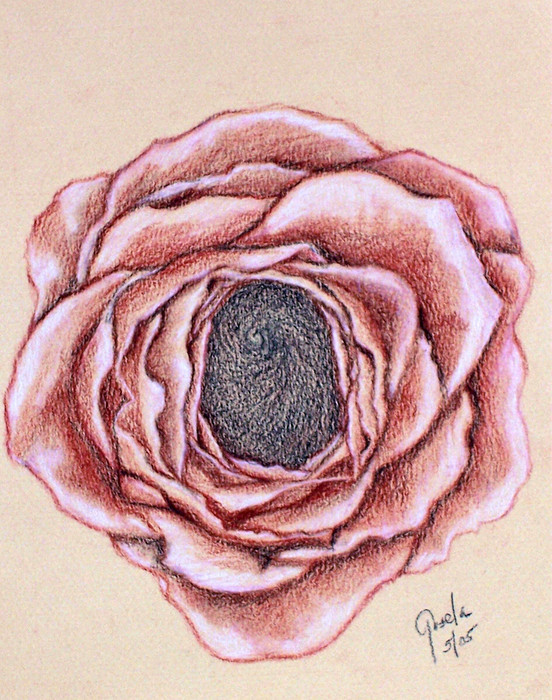Baby emerging in “Crowning Rose”
Crowning Rose
Gisela Llorenz, All Rights Reserved.
UPDATE (8/3/2020): I have learned from Vivian Keeler, the President of HypnoBirthing International that the full name of the artist of this image is Gisela Llorenz. The image is part of the Mongan Method HypnoBirthing Program and can be found as a resource in their materials.
(12/22/2012) After researching this image over the past few months, I have still been unable to locate the artist and copyright information for Crowning Rose (shown above). I originally discovered the image on Birth Bliss’ website and have been in touch with her about it. She notes that the image is connected to HypnoBirthing, but I have not had confirmation yet from the company that this is their image. The signature looks to read “Gisela 5/05.” If anyone has more information on this image, please let me know.
The image is so beautiful and relevant to the visualizing birth concept that I have decided to provide my readers with it at this time. Using soft pencil lines, the artist creates delicate petals of a blossoming rose. As each petal folds outward, a small dark swirl of a baby’s head emerges uniquely from the flower’s center. The petals appear so soft in their opening that the viewer senses the flower to crown almost effortlessly, cradling the baby tenderly as it makes its way into the world.
I have written previously about how helpful images of blooming flowers can be in the visualization of birth (see this Blooming Rose video and these Blooming Flower Visualizations). Indeed, the use of David Bookbinder’s images from the Blooming Flower Visualizations post proved extremely useful, integral and powerful to me during the birth of my second child, Montserrat. In the case of her birth, I actually used the images during early labor to visualize the softening and opening of my cervix.
The pregnant woman can utilize Crowning Rose either to visualize her cervix as ripening and softening (before or during labor), or during the so-called “second stage of labor” when the cervix is fully dilated and the baby emerges from the opening vulva. Either way, the drawing provides her with a clear representation comparing female birth physiology to the fruiting of a rose.

This image is by Gisela Llorenz of Miami, FL.
This image is indeed copyrighted and is part of the Mongan Method HypnoBirthing Program. It was created by Gisela Llorenz. It is in our text book and our supplemental materials.
Vivian Keeler D.C.,CD,HBCE, CH
President, HypnoBirthing International
Thank you for this information, Vivian, and I have updated the post above. Do you know the date of the copyright and also the medium of the artwork? I typically add those in the credits. Thank you!
I met Marie Mongan at a conference in Berkeley in 2015. It was a true honor as I used the Mongan Method in both of my pregnancies. It makes sense that Gisela’s beautiful image would be a part of the Mongan Method. Best wishes, Anna